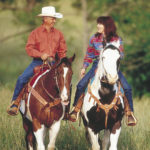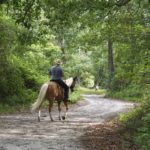Participating in a horse show or other competitive event can be one of the most pleasurable things your child does with horses. Clearing a course of jumps, finessing a reining pattern, galloping a cloverleaf of barrels can be heady experiences, especially before an audience that includes friends and family. And, apart from the fun involved, showing can foster a host of desirable character traits and life skills in your child.
Competitive Advantages
Should your child “show”? Riding competitively increases the time commitment and expense of horse involvement considerably, especially at the higher end. But showing also has so much to offer. Consider this comment, from one of the participants in Dr. Kathy Anderson’s study of 4-H show participation.
“I learned the importance of remaining calm, managing my time wisely, and working with my family to achieve goals,” reported the 15-year-old 4-Her. “Yes, there are stressful times showing horses, but the benefits outweigh the challenges a hundred to one.”
How might showing benefit your child? Here’s a quick summary of what can be learned showing horses:
- Goal achievement. Short- and long-range planning, organization, time management. The values of working hard, paying attention to details, being responsible.
- Team-playing. Working cooperatively with horse, family, instructor, and fellow competitors.
- Sportsmanship. Respect for self and others, grace under pressure, the realization that winning isn’t everything.
- Confidence. Overcoming challenges, learning new skills, becoming a better rider (and perhaps even winning awards).
These benefits, of course, depend on guidance from the right instructor or coach?and from you. We’ll discuss more about that in a moment. First let’s look at the different sorts of showing opportunities available to your child.
Types Of Shows
With advice from your child’s instructor, you may wish to learn more about one or more of the following types of competitions:
- Local club shows, playdays. These low-key events offer a wide range of English and Western classes. Some classes are judged on the quality and performance of the horse or pony (such as halter and pleasure classes); others are judged on the skillfulness and ability of the handler or rider (such as showmanship and equitation classes). Still others involve obstacles (such as the gates and bridges in a trail class, or the fences in a jumper class), or patterns (such as the circles, straight lines, and turnarounds of a reining class). Gymkhanas offer timed obstacle classes such as barrel racing and pole bending.
- 4-H shows. Often held in conjunction with county and state fairs, 4-H competitions offer many of the same types of mounted and in-hand classes as do local club shows. Members who don’t own their own mount can compete on a borrowed horse or pony.
- Hunter/jumper shows. Classes showcase the rider’s form on the flat or over jumps (equitation or “medal” classes), the horse or pony’s form on the flat or over jumps (pleasure/hunter classes), or the horse or pony’s ability to clear a course of jumps within a time limit (jumper classes). Hunter/jumper shows range from small, local, unrated affairs to large events sanctioned by the United States Equestrian Federation (www.usef.org).
- Pony Club events. United States Pony Clubs competitions, called “rallies,” offer a range of English-riding activities, from eventing, show jumping, and dressage to mounted games and vaulting. Members compete as individuals and on teams, and are also judged on the proficiency of their horse care and stable management skills.You, as a parent, are not allowed to help your child when she’s competing in a rally, but qualified adults do oversee all activities.
- Breed shows. These are held by the associations that promote each breed. For example, the American Quarter Horse Association sanctions shows for registered Quarter Horses. Many associations also have youth branches (for example, the American Junior Paint Horse Association; the Arabian Horse Youth Association) that sponsor their own shows. Breed shows and breed youth shows offer a wide range of Western and English classes in various age divisions, and enable youngsters to compete for year-end awards and to qualify for championship events.
- Other competitive opportunities. Many major equestrian disciplines?including barrel racing, competitive trail riding, cutting, dressage, endurance riding, eventing, reined cow horse, and reining?have associations of their own that promote the sport in question and sanction competitions. (See the listing of organizations at the end of this story.)
The Right Approach
To get the most benefit out of your child’s showing activities, follow these general guidelines:
Be coached. Your child’s instructor may be the appropriate person to introduce her to the show ring and guide her progress through the entry levels. If your child discovers she really loves competition and eventually sets major goals, you may need to find a trainer or coach who specializes in the particular type of showing your child wants to do. Either way, in the beginning and later, you need someone who can:
- help target appropriate show venues given your child’s goals and your budget;
- explain all relevant rules;
- prepare your child and her mount for competition;
- advise you on proper gear and attire;
- accompany you and your child to her first shows to provide guidance and moral support; and
- transport your child’s horse or pony, if need be.
Start small. Try a local schooling show first. There, the atmosphere is more relaxed, and the emphasis is on learning and getting a feel for the competitive environment. There’s much to organize and remember when you go to a show; a schooling show gives you a dress rehearsal without the pressure of intense competition.
Maintain perspective. It’s easy to get swept up in the quest for ribbons, but that’s counter-productive, especially at the beginning. Emphasize to your child that the purpose of showing is to have fun, to learn, and to test her progress to see where more work is needed. Remember, your child takes her cues from you; if you remain upbeat and optimistic throughout showing’s ups and downs, your child probably will, too.
Foster sportsmanship. Explain to your child that she’s not competing against others as much as against herself. That way, triumphing over other exhibitors becomes less important than having her best possible ride and improving overall. Don’t allow her to complain about the judging, or to blame her mount. Encourage her to maintain an attitude of respect for all concerned?including herself.
Look for the good. Don’t be too critical of your child’s performance. “A child’s identity, self-worth, and value can never be seen as hinging on the outcome of any event,” cautions Karen Bannister of Brighton, Colorado, who’s coached many children to youth championships in Paint Horse competition. Always find something positive to say about your child’s effort, and let her know she’s still terrific–regardless of whether she wins or loses.
READING, RIDING, ‘RITHMETIC?
So your child is horse-crazy now, but what about when she heads off to college? Will she have to give up her involvement?
Increasingly, the answer is no. In the last dozen or so years, intercollegiate equestrian programs have proliferated like ribbons at a horse show. Driving this phenomenon is Title IX, the ’70s-era federal civil rights law that promotes gender equality in educational programs and activities.
In 1994, given the lopsided figures for money spent on athletics (three-quarters of it going for programs?such as football?that benefit boys), the National Collegiate Athletic Association adopted a principle of gender equity to create more opportunities for girls.
And, because college equestrian teams are largely female, they became instantly desirable as a way to even out the numbers. As a result, in 1998 “equestrian” became an NCAA “emerging sport”?that is, a sport meant to provide more athletic opportunities for female student-athletes.
“We need 40 division I and II schools declaring varsity equestrian programs before NCAA will offer a championship in our event,” says Sheila Murphy, coach of the equestrian team at Massachusetts? Stonehill College. So far 17 division I schools and four division II schools offer varsity equestrian. (For more information, including how to start an equestrian program at your college or university, go to www.varsityequestrian.com.)
Collegiate riding groups. Helping to fuel the gallop to equestrian are a number of organizations, most notably the Intercollegiate Horse Show Association. Established in 1967, the IHSA now encompasses more than 300 member colleges in 45 states and Canada. Participating students needn’t own horses; they ride mounts furnished by the host colleges.
“It’s a way to expand riding opportunities for students regardless of financial status or riding level,” explains IHSA founder and executive director Bob Cacchione.
Divisions exist for both English and Western riders, who compete as individuals and on teams to qualify for regional and zone finals. At the national championships, winners receive trophies sponsored by the United States Equestrian Federation, the American Quarter Horse Association, and the National Reining Horse Association.
Other organizations fostering college-level equestrian programs include the Affiliated National Riding Commission (hunter seat riding only), the Intercollegiate Dressage Association, the National Intercollegiate Rodeo Association, and the United States Polo Association.
High school, too. At the younger levels, the Interscholastic Equestrian Association, established in 2002, hopes to do for middle and secondary schools (students age 11 through 19) what the IHSA and other groups have done at the college level.
Founder Roxanne Rheinheimer, director of the equestrian program at The Andrews School in Willoughby, Ohio, envisions schools providing access to equestrian sports the way they now provide other athletic competitions, using horses and arenas at colleges or local barns.
To learn more about all these groups, see the contact information at the end of this story.
For more information related to this topic, go to:
www.equisearch.com/horses_care/health/grooming/showessentials042201b
www.equisearch.com/horses_riding_training/training/beginning_rider/eqcarroll2802)
Helpful Contacts:
Affiliated National Riding Commission
www.anrc.org
American Endurance Riders Conference
aerc@foothill.net
Intercollegiate Dressage Association
www.teamdressage.com
Intercollegiate Horse Show Association
webmaster@ihsa.com
www.ihsa.com
Interscholastic Equestrian Association, Inc.
info@rideiea.com
www.rideiea.com
National Barrel Horse Association
nbha@nbha.com
www.nbha.com
National Cutting Horse Association
www.nchacutting.com
National FFA (Future Farmers of America) Organization
www.ffa.org
National High School Rodeo Association
info@nhsra.org
www.nhsra.org
National Intercollegiate Rodeo Association
509-529-4402
National Reined Cow Horse Association
nrcha@brightok.net
www.nrcha.com
National Reining Horse Association
www.nrha.com
National Snaffle Bit Association
www.nsba.com
North American Trail Ride Conference
natrc@natrc.org
www.natrc.org
United States Dressage Federation
usdressage@usdf.org
www.usdf.org
United States Equestrian Federation, Inc.
www.usef.org
The USEF, national governing body of equestrian sport in the United States, is a member of the U.S. Olympic Committee and the Federation Equestre Internationale (FEI).
United States Eventing Association, Inc.
info@useventing.com
www.eventingusa.com
United States Polo Association
uspa@uspolo.org
www.uspolo.org
United States Team Penning Association
www.ustpa.com
United States Team Roping Association
www.ustrc.com





